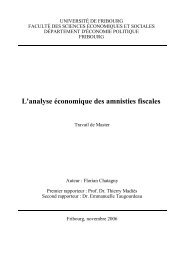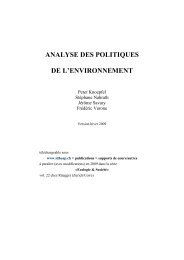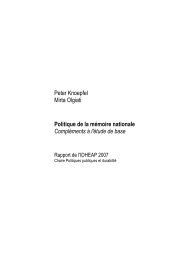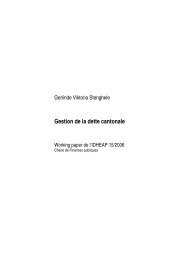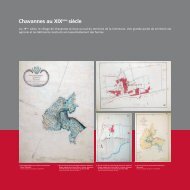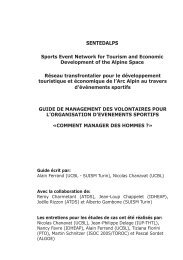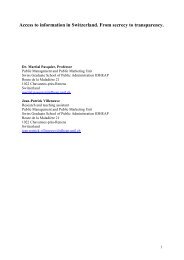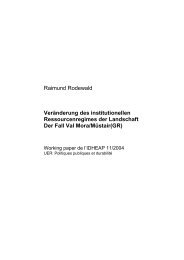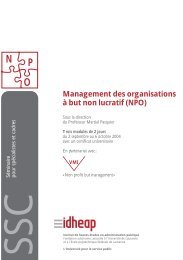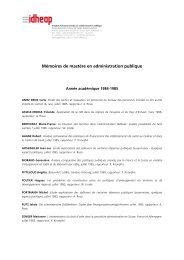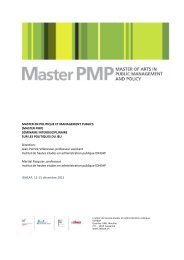Voting advice applications and party choice: evidence from ...
Voting advice applications and party choice: evidence from ...
Voting advice applications and party choice: evidence from ...
You also want an ePaper? Increase the reach of your titles
YUMPU automatically turns print PDFs into web optimized ePapers that Google loves.
368 A. Ladner, J. Fivaz <strong>and</strong> J. Pianzola<br />
political parties, political representation, <strong>and</strong> eDemocracy. In 2009, he obtained<br />
a Master of Arts in History, Political Science <strong>and</strong> Economics. Since 2003, he<br />
has been involved in the development of the voting <strong>advice</strong> application (VAA)<br />
smartvote.<br />
Joëlle Pianzola studied Political Science, English Linguistics <strong>and</strong> European<br />
Law at the University of Bern <strong>and</strong> University of Helsinki. She is currently<br />
writing her PhD in Political Science at IDHEAP, University of Lausanne. Her<br />
research interests are electoral behaviour, political psychology, democratic<br />
processes <strong>and</strong> e-democracy.<br />
This paper is an revised <strong>and</strong> exp<strong>and</strong>ed version of a paper titled ‘Impact of<br />
voting <strong>advice</strong> <strong>applications</strong> on voters’ decision-making’ presented at the<br />
conference ‘Internet, Politics, Policy 2010: An Impact Assessment’, Oxford,<br />
16–17 September.<br />
1 Introduction<br />
<strong>Voting</strong> <strong>advice</strong> <strong>applications</strong> (VAAs) have become increasingly popular over the last<br />
several years. Today, they have established themselves as essential parts of most major<br />
electoral campaigns. During the 2007 electoral campaign in Switzerl<strong>and</strong>, the VAA<br />
smartvote (http://www.smartvote.ch) was used by about 375,000 voters (Fivaz <strong>and</strong><br />
Nadig, 2010; Ladner et al., 2010). In relation to the 2.4 million voters who participated in<br />
the election, this means that about 15% of voters used smartvote prior to their electoral<br />
decision-making.<br />
Similar developments can be observed in a number of other countries. In Germany,<br />
for instance, the VAA Wahl-O-Mat (http://www.wahl-o-mat.de) delivered 6.2 million<br />
voting recommendations for the 2009 elections, which corresponds to about 12% of the<br />
electorate (Garzia, 2010). The Netherl<strong>and</strong>s are probably the country where VAAs are<br />
most popular. In the weeks before the 2010 elections, the VAA Stemwijzer<br />
(http://www.stemwijzer.nl) delivered 4.2 million voting recommendations, while the<br />
VAA Kieskompas (http://www.kieskompas.nl) added another 1.5 million to the total of<br />
5.7 million voting recommendations (Louwerse <strong>and</strong> Rosema, 2011). Thus, the number of<br />
voting recommendations issued in 2010 corresponds to more than 50% of Dutch voters.<br />
With regard to this widespread popularity, it is not surprising that, in recent years,<br />
VAA-related research has drawn attention more <strong>and</strong> more to the question of whether<br />
VAAs affect the electoral decisions of their users. Several studies have conducted online<br />
surveys among VAA users <strong>and</strong> asked them directly whether the received voting<br />
recommendations had an impact on their <strong>party</strong> <strong>choice</strong>s. In the Swiss case, about 70% of<br />
users stated that they were affected by the VAA smartvote in their vote <strong>choice</strong>s (Ladner<br />
et al., 2010b). This is an unusually high figure <strong>and</strong> might be due to the complexity of the<br />
Swiss electoral system <strong>and</strong> the far-reaching possibilities involved in the voting process<br />
compared to other countries.<br />
Therefore, the smartvote users were asked more precisely how the smartvote<br />
recommendations affected their voting decisions. Only 15% of those who were<br />
influenced stated that they had adopted the recommendations in their entirety <strong>and</strong> copied<br />
them onto the ballot papers. The other users adopted the recommendations only partially.



